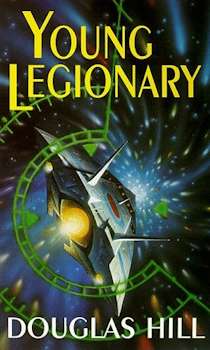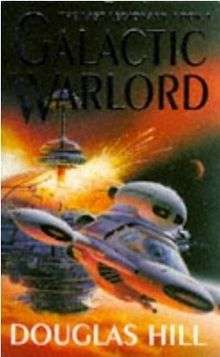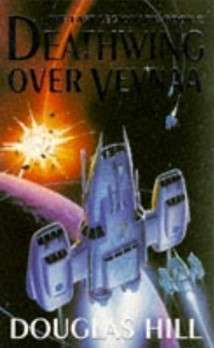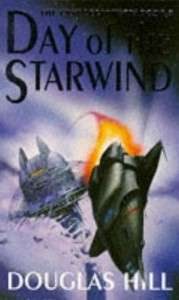Last Legionary
The Last Legionary series is a series of five books written by Canadian author Douglas Hill. The books are Young Legionary, Galactic Warlord, Deathwing Over Veynaa, Day of the Starwind and Planet of the Warlord. The series has been described as a simplified version of E. E. Smith's Lensman series.[1]
The books tell of the adventures of Keill Randor, the last survivor of his planet's population, who are annihilated at the beginning of the book Galactic Warlord. Randor's people were hardened over generations by their inhospitable planet, which (combined with rigorous combat and martial arts training) resulted in them exhibiting speed, reflexes, strength, and fighting abilities all at the very upper limit of human ability and Randor himself is one of the most skilled amongst them, twice winner of the planetwide martial arts contest, a feat bettered by only one other legionary in the history of the contest. The people of Moros acted effectively as mercenaries; however they were careful to only offer their services to clients fighting in self-defense. After they are all killed by a mysterious villain known only as the Warlord, Randor vows to avenge them.
Plot
Young Legionary (1982)

A prequel written after the other books in the series, Young Legionary follows Keill Randor through his childhood, from the age of 12 to 18 (within four distinct stories), as he struggles to meet the requirements of becoming a Legionary. The novel also introduces his close friend, Oni Wolda.
Galactic Warlord (1979)

As the book begins, Keill Randor is the leader of an off-world Strike Team, far from home. He receives a distress signal from his home planet Moros, stating that they are under attack from unknown forces. Keill's ship has suffered damage, and he is unable to immediately return to Moros. When he arrives, the entire planet is covered with radiation. He is met by Oni's ship, and she tells him to flee the planet; a deadly radiation is killing everyone who comes close to the surface. At the end of Oni's speech, it is revealed that it is an automated message: Oni herself is dead. In grief Keill leaves the planet. He soon realizes that he has still been mortally exposed – the radiation is eating through his body at a slow, though inevitable rate.
Keill begins to search for any fellow Legionnaires who may have survived, relying on his extreme physical conditioning and iron will to fight the course of the disease. His search is fruitless, as it appears he truly is the last Legionary. As Keill begins to lose hope, he is contacted by an unknown agency, but he ignores the contact to pursue some rumors of apparent survivors of Moros. Shortly afterwards, he is attacked outside his ship, and loses consciousness.
Keill wakes as an apparent prisoner, immobilized within what appears to be a medical facility. Keill's extreme physical conditioning allows him to recover quickly, and he discovers that he has been completely healed of his radiation sickness by a strange group known only as The Overseers. This group has a network of satellites throughout the galaxy that give an overview of all events throughout the galaxy. The Overseers' leader, Talis, explain to Keill that his home planet was destroyed by a malevolent entity known as 'The Warlord' whose sole aim is to spread war through the galaxy, enabling him to rule over the remains that survive. The Warlord moved against the Legions since he perceived them as the greatest threat to his plan. The Overseers also explain that, since the radiation sickness had settled into his bones, they were forced to replace his entire skeleton – using an unbreakable alloy – effectively rendering Keill's bones unbreakable. They also reveal how they captured Keill so easily – a telepathic avian life form from another galaxy known only as 'Glr'.
With Glr as his companion, a skeptical Keill moves to meet with the Legionaries he found evidence of. He quickly finds that they are in fact agents of a shadowy force known as the Deathwing, and that everything the Overseers told him was true. With the help of Glr, and his prodigious abilities, Keill manages to defeat them; in doing so he takes on their leader from the Altered Worlds, Thr'un, a giant of a man who can temporarily grow plates of armor from within his body. After eventually killing him, a wounded Keill then agrees to collaborate with his new friends to find, and destroy, the Warlord.
Deathwing Over Veynaa (1980)

Keill Randor is sent to a planet by the Overseers, to determine if their recent turn to aggression has its roots in the Warlord's influence. On the planet, he encounters a new leader, an albino called Quern. It transpires that Quern is an altered human, and strongly telepathic, though Glr is able to shield Keill's mind from Quern's probing. Quern has developed a planet-killing weapon, and has convinced the ruling council that this weapon justifies their new aggression. They are attacking from a position of absolute strength. The weapon turns out to be the very same weapon which killed Keill's planet; a form of radiation spore which multiplies rapidly in an oxygen atmosphere, killing every living thing.
Keill manages to kill Quern (and his secret ally) and the ship which carried the weapon is sent into "over light" (hyperspace) without any exit coordinates.
Day of the Starwind (1980)

Keill Randor is sent by the Overseers to investigate a planet, where there have been rumors of a strike team operating – men who display incredible martial prowess, and uniforms which resemble the Legions. The planet is periodically orbited by a moon, and the close proximity of the moon causes a massive wind, called the Starwind. It typically flattens everything on the planet, yet on the planet is a tall tower protected by a force field. Keill quickly encounters a group, and is surprised that he recognizes the members of the strike team. They are famous Legionaries from decades ago. It quickly becomes apparent that they are clones. The group is led by Altern, an altered human clothed in a flexible gold-like metal exoskeleton. The strike team are eager to try their skills against a real Legionary, but when given the chance, Keill defeats them. As the Starwind begins, Glr is finding it harder and harder to fly and avoid the patrols who are looking for her. When Keill loses contact with her, he assumes she has been shot and killed. Finally, when Keill faces Altern in single combat, Altern reveals that he is "The One," the Warlord's right-hand man. Keill shoots him with a laser, apparently killing him.
As Keill tries to get to the roof of the tower to get to an escape craft, the starwind is ever increasing in strength. As Keill gets to the roof, he sees that Altern has survived, but is now without his exoskeleton. The fleshy body, with tentacles instead of legs, crawls into the escape craft, and takes off. Keill thinks he is about to die, but Glr arrives at the last second in their ship to rescue him.
Keill is determined to find Altern again.
Planet of the Warlord (1981)

Keill Randor has left the Overseers, and abandoned their plan of subtle investigation. He has entered the Battle Rites of Banthei, a galactic ultimate fighting contest. He is the first person in 80 years to enter it unarmed, and his progress through the early rounds of the contest has made him famous throughout the galaxy. This leads to the Warlord sending a strike team to try to kill him, and while Keill pursues a gunman, he is captured, rendered unconscious and taken to the far side of the Galaxy.
There, on the planet Golvic, he meets Altern again (a.k.a. "The One"), and is introduced to the "Warlord". The Golvicians had created an Arachnis technological device, which was capable of linking minds. The Warlord was actually a group mind of Golvician scientists, linked by Arachnis. Though Keill tries to fight them and kill them, one touch from an Arachnis tendril enslaves him mentally.
From this point on, the automaton which used to be a man called Keill Randor trains recruits for The One. He sometimes hunts Glr, too. The One takes pleasure in abusing the automaton, but since there's no part of Keill Randor left, there's little to be gained from this.
When the Warlord gained access to Keill's mind, they learned about Glr, her abilities, the Overseers asteroids, the nature of his unbreakable bones, and every other secret.
A long time goes by, until one time while trying hunt down Glr, Keill's Arachnis link is torn from his head, by Glr. Normally this would result in mind death, but the iron hard will power of the Legionary, determined to survive, keeps him alive. Glr psychically helps him heal from the mental trauma. When he is recovered, she tells him that she lost contact with Talis in the same way, meaning that they have also been enslaved by Arachnis.
Because Glr now has the coordinates of the asteroid, Keill goes on a rescue mission. His familiarity with the troops he has trained under The One allows him to defeat them in combat. Glr frees Talis from the Arachnis link, and in combat with The One in front of the 24 Golvicians who make up the Warlord group mind, Keill manages to destroy both The One and Arachnis. Without the link to sustain the group mind, the 24 go insane and die.
With the Warlord defeated, Keill is now a man without a mission, and to combat a life of boredom, Glr suggests that they take her craft, capable of intergalactic flight, and explore the universe. Keill gladly accepts.
Literary reception
Anne Osborn in the School Library Journal did not have much good to say about Young Legionary. She says that "Hill's trademark, non stop action is at its best; the pages go by in a blur. The pace slows down only when the author attempts to deal with a complex relationship; he has no feelings for emotional subtleties; sentence fragments grate. Discerning readers may be disappointed by the comic book plot and hackneyed prose".[2]
Jerry Spiegler in the School Library Journal describes Keill Randor as the cybernetic Bruce Lee of the future. He says that "readers will enjoy the fast-paced action as long as they don't mind the many violent confrontations. Not great literature but a lot of fun and excitement".[3]
Mary I. Purucker in the School Library Journal said that Day of the Starwind was "full of action, cave-dwelling monsters and violence, this moves along at a good clip and leaves readers breathlessly waiting for the next in the series".[4]
Carolyn Caywood in the School Library Journal said that Galactic Warlord was "pure space opera, pitting heroes against evil doers with lots of action but no real insight. The story is fast paces, readable though no easy, and will have wide appeal among those teens who have enjoyed recent movie and television science fiction".[5] She said of a sequel that "the constant action does not advance readers' knowledge about the Warlord, suggesting that several more books are planned before Keill finally catches up with his enemy. Like its predecessor, this is a successful imitation of the currently popular space movies. It is not as interesting, however since most of the development of the characters and settings takes place in the first book".[6]
References
- ↑ Sullivan, C.W. (1999-03-30), Young Adult Science Fiction (Contributions to the Study of Science Fiction and Fantasy), Greenwood Press, p. 44, ISBN 978-0-313-28940-8
- ↑ Osborn, Anne (December 1983). "Young Legionary (Book)". School Library Journal. Vol. 30 (Issue 4). p. 74. ISSN 0362-8930.
- ↑ Spiegler, Jerry (August 1982), "Planet of the Warlord (Book)", School Library Journal, Vol. 28 (Issue 10), p. 126, ISSN 0362-8930
- ↑ Purucker, Mary I (November 1981), "Day of the Starwind (Book)", School Library Journal, Vol. 28 (Issue 3), p. 104, ISSN 0362-8930
- ↑ Caywood, Carolyn (April 1980), "Galactic Warlord (Book Review)", School Library Journal, Vol. 26 (Issue 8), p. 125, ISSN 0362-8930
- ↑ Caywood, Carolyn (August 1981), "Galactic Warlord (Book Review)", School Library Journal, Vol. 27 (Issue 10), p. 75, ISSN 0362-8930